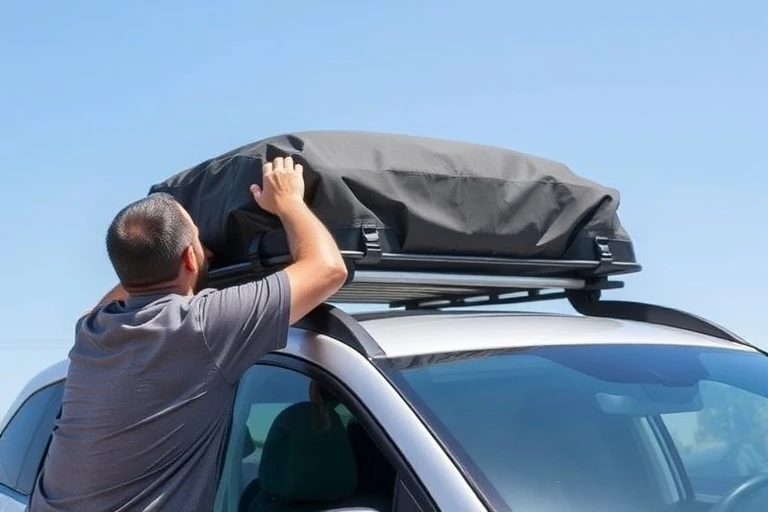If you love travelling or camping, you must know how important it is to install a rooftop cargo bag. But if you are still a new travelling or camping enthusiast, you are in the right place.
In this article, we will discuss roof cargo bag installation and other factors such as:
-Types of cargo bag
-How to install a roof cargo bag
-Things to consider when installing rooftop cargo bag
Whether you’re gearing up for a road trip, getting ready for camping, or just need more room for your stuff, knowing how to attach a rooftop bag properly is essential. So, before we learn how to install a cargo bag, let’s see which is best for you.
Types of cargo bags that are best for you
When picking out a way to carry your stuff, like bags or racks, think about what you need. Consider how much stuff you have and if you need it to stay dry in the rain. Different options have good and bad points, so choose what works best for you!
Three types of cargo bags are usually available online or in stores:
1. Roof Bags
2. Roof Basket and Tray
3. Roof Boxes
Roof Bags
Roof bags shield your gear from the weather and come with straps for mounting on a naked roof, roof basket, or crossbars. They’re cheaper than roof boxes and easier to store. Unlike boxes, they can’t be locked for extra security and are less aerodynamic. While they offer some protection, it’s not as much as hard shell boxes.
Roof Basket and Tray
Roof baskets and trays offer a sturdy platform to stack and secure your gear. But on their own, they don’t keep your stuff dry in the rain. If you need that, you’ll have to add a weatherproof bag to the mix.
Roof Boxes
Roof boxes provide top-notch security and weather protection, keeping your gear safe and dry. They usually come with locks for added security. However, they’re pricier and bulkier to store compared to other options. Unlike roof bags, you need a roof rack to attach them; they won’t work on a bare roof.
Installing Cargo Bag to Roof Rack
Once your roof basket or tray is set up, load your items onto it. Use tie-down or ratchet straps to fasten your gear to the carrier securely. The first picture shows you can connect a strap to anchor points. Alternatively, wrap the straps under the crossbar on each side of the vehicle and tighten the buckles to secure everything in place.
You can also use a roof luggage rack net to help keep your belongings secure. However, finding one that fits your load properly can be tricky, so relying solely on a net might not hold your gear tightly enough. It’s best to use straps to secure your belongings first. Some cargo nets even come with cargo straps for added convenience.
Important note: Choose a strap with a safe working load limit (WLL) that can handle the weight of your cargo. Ensure the combined WLL of the straps doesn’t exceed your cargo’s weight. For example, if each strap has a WLL of 500 lbs. and your load is 1,000 lbs., use at least two straps. To find the maximum load or break strength, multiply the WLL by 3. Remember, the WLL is one-third of the maximum load. Using straps in pairs adds extra security.
Installing Cargo Bag without Roof Rack
If your car has a roof rack, installing a rooftop carrier is simple. But even without one, there’s a solution. RoofPax offers a versatile roof rack storage system that fits any vehicle. With ten sturdy straps, you can attach it to raised side rails, a roof rack, a basket, or bars. Our six patented door hook straps provide a safe option for cars without traditional racks, ensuring no interference with airbags during emergencies.
Six easy steps to install cargo bag without a roof rack
Step 1: Get Your Gear Together:
Before you start, ensure you have everything you need: your RoofPax Car Roof Bag, RoofPax air compressor (if you want), and any other accessories you use.
Step 2: Prep Your Ride:
Clean and dry your car’s roof well. If it has raised side rails, ensure they’re clear of dirt or debris.
Step 3: Keep the Bag in Correct Position:
Place your RoofPax Car Roof Bag on the roof, ensuring it’s centred and aligned with the rails.
Step 4: Strap It Down:
Use the straps provided to secure the bag to your roof. Wrap them around the rails and through the loops on the bag, then tighten them up for a snug fit.
Step 5: Check It’s Secure:
Once the straps are on, gently shake the RoofPax Car Roof Bag to ensure it’s firmly attached.
Step 6: Load Up:
Now that your bag is in place start loading your gear into it. Make sure the weight is spread evenly for a safe journey.
Things to consider when installing rooftop cargo bag
Remember three important points for a secure and safe installation when setting up your rooftop cargo bag. First, distribute the weight evenly to avoid strain on your vehicle. Second, protect your vehicle’s surface by ensuring it’s clean and using a protective mat if needed. Lastly, secure and tighten the straps properly to keep your cargo bag in place during your journey. Considering these considerations, your rooftop cargo bag will be installed safely and securely, ready for your next adventure.
Distribute Weight Evenly
Distributing weight properly when loading your rooftop cargo bag is crucial to ensure vehicle stability. Place heavier items at the bottom of the bag, closest to the roof, and lighter items on top. This arrangement lowers the vehicle’s center of gravity, minimizing the risk of swaying or instability while driving.
Protect Your Vehicle’s Surface
When installing a cargo bag without a roof rack, protecting your vehicle’s surface is important. Place a protective layer between the cargo bag and the roof, such as a soft blanket, non-slip mat, or bubble wrap. This layer acts as a buffer, reducing the risk of scratches or dents caused by friction or movement of the bag.
Secure and Tighten the Straps
Before hitting the road with your car top carrier, ensure all straps are securely fastened and tightened. Double-check them to prevent loosening from wind or vibrations during transit. Regularly inspect the straps during stops and consider using extra securing measures like knotting or bungee cords for added stability and peace of mind.
Test and Adjust Before Final Drive
Before you hit the road, test the rooftop cargo carrier by gently tugging and rocking it for stability. Adjust as needed for a secure fit. Follow these six installation tips for a stress-free journey with ample storage space. Prioritize safety, weight distribution, and proper mounting techniques. Always refer to the manufacturer’s instructions and seek professional advice if needed.
Final Words
Now that you have a detailed idea about installing a rooftop cargo bag, you can have a safer journey without worrying. Do not forget to share this information about cargo bag installation with your loved ones
I hope you enjoy every one of your rides with everything you need. Have a good day, stay safe and secure.

